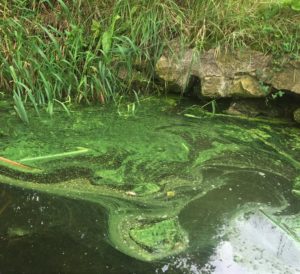Penn Lake: Recreational Water Advisory Issued
Updated: July 28, 2025
Penn Lake: Recreational Water Advisory Issued
WARNING- The public should avoid contact with the water in Penn Lake in Bloomington.
The water contains blue-green algae at levels that may cause short term and long term harm including skin irritation, gastrointestinal problems, liver damage, and the potential for acute poisoning. People and pets should avoid all contact with the water, scum, or algae.
Based on analysis of water samples from Penn Lake during the week of July 21, 2025, and the presence of blue-green algae scum where whole-body contact can occur, World Health Organization (WHO) guidance indicates a high probability of adverse health risks from algal toxins.
Blue-green algae are a concern because this type of algae can produce algal toxins, which can pose a health threat for pets and people when concentrations become high enough. Algal toxin testing has not occurred on this lake. The district will collect additional samples from Penn Lake and will release updated information on algal levels on this page when it is available following the sampling event.
Always remember, when in doubt, best keep out. The district is on the look-out for suspected blue-green algae blooms in the lakes that are part of its yearly monitoring program. If you suspect a blue-green algae bloom, you can email pictures of the suspected bloom to algae.mpca@state.mn.us.
For more information on harmful algae blooms, you can also call the Minnesota Pollution Control Agency at 651-757-2822 or 800-657-3864. In addition, report human health effects to the Minnesota Department of Health (MDH) Foodborne and Waterborne Illness Hotline at 1-877-366-3455. For health questions, citizens can contact MDH’s Waterborne Diseases Unit at 651-201-5414 or visit the MDH’s Harmful Algal Bloom web page.
For more information on blue-green algae and harmful algal blooms visit or view the frequently asked questions below:
WWW.PCA.STATE.MN.US/WATER/BLUE-GREEN-ALGAE-AND-HARMFUL-ALGAL-BLOOMS
WWW.HEALTH.STATE.MN.US/DISEASES/HAB/INDEX.HTML
FREQUENTLY ASKED QUESTIONS
WHAT ARE BLUE-GREEN ALGAE BLOOMS AND CYANOTOXINS?

Blue-green algae are a type of cyanobacteria present at low levels in many Minnesota lakes and ponds. When water is stagnant, warm and rich in nutrients – especially phosphorus – cyanobacteria can grow quickly, forming “blooms.” These blooms typically look like pea soup or bright green paint. These blooms can last several weeks or longer and are considered harmful (harmful algal blooms or HABs) since they can produce toxins, called cyanotoxins, which can harm humans and animals. Always remembers, when in doubt, best keep out.
WHAT ARE THE HEALTH EFFECTS FROM CYANOTOXINS?
Blue-green algae and cyanotoxins have been shown to cause acute inflammatory effects or illnesses. Exposure to blue-green algae while in recreational waters may cause skin irritations, including rashes, hives, swelling or skin blisters. Ingestion of cyanotoxins can also cause more severe health effects such as liver or kidney damage, depending on the cyanotoxin and the magnitude, duration and frequency of the exposure. Health effects from cyanotoxin exposure in pets, wildlife, and livestock can include vomiting, diarrhea, seizures, and death.
HOW DOES CYANOTOXIN EXPOSURE OCCUR?
Exposure to blue-green algae and their toxins may occur by accidental ingestion or inhalation of toxin-contaminated water, or skin contact during recreational activities (for example, swimming, water skiing, or tubing). Animals such as pets, livestock, and wildlife may also be exposed to cyanotoxins if they drink water from toxin-contaminated water bodies, lick their fur after swimming in such waters, or consume toxin-containing algal scum or mats.
IS ANY BLUE-GREEN ALGAE BLOOM POTENTIALLY DANGEROUS?
Yes. Any blue-green algae bloom may potentially cause harm, and it is difficult to tell by looking at a bloom if it is producing toxins. To determine if the bloom is producing toxins, it needs to be tested by trained personnel.
WHAT TYPES OF ALGAE ARE ASSOCIATED WITH TOXINS?
Blue-green algae are photosynthetic bacteria that can produce toxins.
WHAT IF I SUSPECT A BLUE-GREEN ALGAE BLOOM?
If you suspect a blue-green algae bloom email pictures of the suspected bloom to algae.mpca@state.mn.us. For more information on harmful algae blooms, you can also call the Minnesota Pollution Control Agency at 651-757-2822 or 800-657-3864. In addition, report human health effects to the Minnesota Department of Health (MDH) Foodborne and Waterborne Illness Hotline at 1-877-366-3455. For health questions, citizens can contact MDH’s Waterborne Diseases Unit at 651-201-5414 or visit the MDH’s Harmful Algal Bloom web page.
